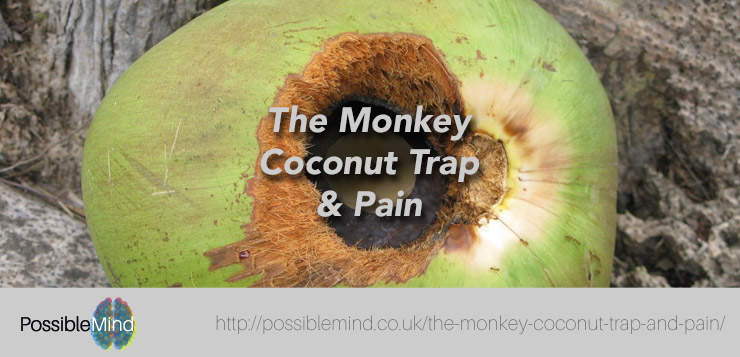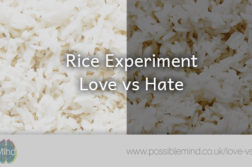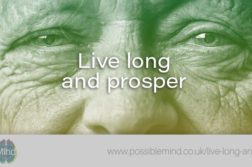A monkey coconut trap is created by cutting a hole in a Coconut and placing a piece of banana inside. The Monkey then puts its hand in the hole and grabs the piece of fruit. The hole is not big enough to get the monkeys fist out. All the monkey needs to do is let go of the banana, most don’t and are trapped and caught.
Pain leaves many of us feeling trapped, just like the monkey we can reduce our pain by letting go of the banana called suffering.
This is not to say we are monkey like, it’s just that we have fallen in to a trap of thinking that our life with pain is how it will always be. We are doing our best but letting go of the pain and suffering often seems illogical. Like losing the piece of fruit, the fear is that we will lose our control and the pain will overcome us. It is true if the monkey lets go off the banana he will loose it, but will gain his freedom, it is the same for those of us in pain. Letting go requires us to accept the current situation of being in pain and then relax to allow it to flow through us. It doesn’t seem to make sense however, the following quote and metaphor helps explain it.
A feeling only has one purpose and that is to be felt.
Everything is going to be felt in the end either now if we relax or if we tense it could last longer. It is a little like a drive home from work that usually takes 30 minutes but today there are road works and you are queued back and it going to take alot longer. The road works represent the tension you are feeling around pain. When we let go we are in effect freeing up the pain to flow, like a clear road home, and being felt. After the pain has been felt, what will be left?
It sounds great but it is scary right? The worry of letting it go and flow. I think of it like removing a plaster (or band-aid) quickly or slowly. It is the same pain but one is over really quickly while the other lasts longer and causes more suffering.
According to the pain equation by Shinzen Young it is the resistance that causes our suffering and if we don’t resist the situation we are then left with only the sensation of discomfort (or pain).
An interesting perspective by Mark Manson, which I read recently encourages us to understand and accept that we have two minds and uses this to examine our body, thoughts and feelings.
The premise of Mark’s article is this that we have a thinking mind, which is always on the go analysing and coming up with theories and ideas.
He asks us to try and not think of a pink elephant with a blue umbrella. Go on try it for 30 seconds.
It is impossible because the moment you attempt not to think of it you have already thought of it. This is frustrating, but this frustration also holds the answer to the key of letting go and feeling.
Which part of you is viewing this frustration when trying not to think of the elephant. It is suggested that it is the observing mind or the consciousness of ‘I’ as it has been labeled by Psychosynthesis.
The Consciousness of ‘I’ is described as the unchanging part of us all that has been aware of all our emotions, thoughts and our body our whole life. It’s the part of you that has been constant throughout your whole life, it is the true you. Psychosynthesis argues that seeing as our though our emotions, thoughts and body are always changing from happy to sad, young to old, gain knowledge and changing ideas, they can not be who we truly are. That constant part of us can only be the part of us that observes it all and always has.
Psychosynthesis then teaches us to dis-identify or defuse from our emotions, thoughts and body by understanding that we:
- Have a body, but are not our body.
- Have emotions, but are not emotions.
- Have thoughts, but are not our thoughts.
By identifying ourself as the Conscious ‘I’ we can view our pain, sensations, thoughts and emotions from the position of an unattached observer, meaning we are defused. From this position we can, as Zen has taught us, learn to respond and not react to the sensation of discomfort.
The difference between responding and reacting is that by being in the position of the observer we can give our self space to choose the best option for ourself in each individual situation. If we react we are using on our fused mind, but we are so much more than this when learn to remember. Mark Manson describes it like this:
Most of our psychological and emotional stress happens because our Thinking Mind and Observing Mind are “fused” and we don’t recognize the difference.
By taking the position of the observer and recognising this as our Conscious ‘I’ and true self enables us to escape the Monkey or psychological trap by watching and dis-identifying with the sensations, thoughts and emotions to be able to direct our life and current situation in the best direction for us.
In different ways to Psychosynthesis who sees the mind as it’s own entity and the conscious ‘I’ as the persons constant being through out their life, Mark Manson sees the mind as having two elements:
The trick is to accept them [thoughts, feeling and the body] and then let go. This is a skill and it is a process, but it cannot be practiced until you recognize that there are two minds and you only control one of them.
I tend to lean towards the Psychosynthesis way of thinking, however it is finding the best solution for you to dis-identify and defuse to enable you to let go of the pain and feel it through as quickly as possible.
Learning to free yourself from the trap by becoming the observer or identifying yourself as the Counscious ‘I’ can be very helpful in helping us escape our pain related version of the monkey trap.
Further Reading
This interesting article from The Synthesis Center.
or
Mark Manson’s post about the Two Minds.






